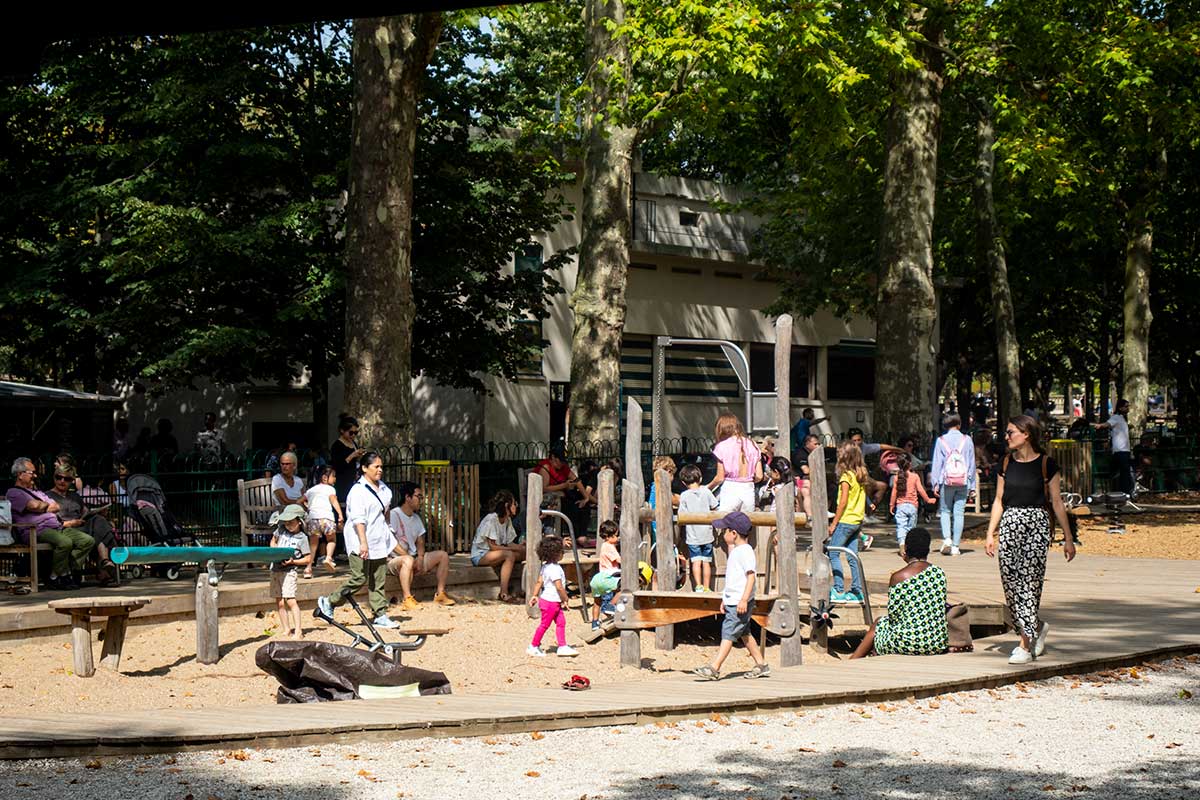Welcome to our guide to the Jardin du Luxembourg, the largest park in Paris. It’s one of the most famous green spaces in the French capital, as well as one of the most iconic and beautiful.
You could easily spend half a day there or more, especially if you’re visiting Paris with kids. The Jardin du Luxembourg is over 400 years old, and its home to one of the finest palaces and most beautiful fountains in Paris. It was one of my favourite places to visit in Paris when I lived there, and somewhere I love to return whenever I’m in the city.
There are also some great things to do in the Jardin du Luxembourg for kids, with a puppet theatre, charming wooden carousel and much more. The park is also a great place to watch Paris go by for a while.
Our Jardin du Luxembourg guide shows you the many things to do and see there. We also advise on the best ways to get there, and places to see nearby.
Why Visit The Jardin du Luxembourg



The Jardin du Luxembourg is the largest and one of the most beautiful parks in Paris.
The Gardens appeal to visitors of all ages – you can come to admire the late Renaissance architecture, enjoy a romantic picnic or spend a few hours reading or playing chess.
It’s one of the best places in Paris for kids, with several great attractions, from sailing boats to a vintage wooden carousel from 1879. There is also a great new playground with sections for children of different ages.
The formal flower gardens of the Jardin du Luxembourg are among the most beautiful in Paris. There is also some less formal English-style parkland around the fringes.
The Jardin du Luxembourg is also a wonderful place to immerse yourself in Parisian life. You can watch a game of boules or tennis, or sit somewhere to people-watch and see the world go by.
Jardin du Luxembourg History


In 1611, Marie de Medici, widow of assassinated French King Henri IV, decided to move from the Palais du Louvre to a new residence.
She chose the site of what is now the Jardin du Luxembourg, less than a mile (a little over 1 km) south of the Louvre.
She ordered the construction of a new palace inspired by the Palazzo Pitti in her home city, Florence. This was undertaken by Salomon de Brosse.
The name ‘Luxembourg’ is believed to be derived from Mons Lucotitius, the hill on which the Garden is built.
Large gardens – around 8 hectares in size – were planted, with around 2,000 trees, and the Medicis fountain was completed by Tommaso Francini in 1630.


The Jardin du Luxembourg was eventually expanded around the time of the French Revolution. Land occupied by the Carthusian Monastery on the edge of the Garden was finally acquired, increasing the size of the Garden to around 40 hectares.
Napoleon Bonaparte took up residence in the Palais du Luxembourg in 1799. Soon afterwards it was turned into a government building, a function it has served over much of the following two centuries.
The Palais is now home to the Senat (Senate), the upper chamber of the French government, which owns the Jardin du Luxembourg.
Things To Do In The Jardin du Luxembourg Paris
Relax At The Medicis Fountain

The Fontaine Medicis – Medici Fountain – is my favourite place in the Jardin du Luxembourg. I first stumbled upon it while living in Paris back in 1992, thinking I had found a small corner of paradise, I was not wrong.
The fountain was commissioned by Marie de Medici and completed around 1630. Tommaso Francini’s original design was a grotto and fountain, and it was located elsewhere in the Jardin du Luxembourg.

It was restored in the early 19th century on the orders of Napoleon, and moved in the 1860s to make way for a new road. The fountain was completely remodelled, with new statues (Polyphemus discovering Acis and Galatea) and a much longer water basin.
It’s a wonderful place to relax, especially in the heat of summer, in the shade of the trees either side. The water also has a cooling effect, and it’s one of the most beautiful places in Paris you’ll ever discover.
Sail A Boat In The Grand Bassin


If you’re in Paris with kids, it’s well worth scheduling a visit to the Jardin du Luxembourg on a Wednesday or weekend. This is when you can sail wooden boats on the Grand Bassin, the octagonal pond in the middle of the park.
It’s all very simple but wonderful fun. You pick a wooden boat with a sail and a stick, then set it into the water, then give it a prod to send it on its way. It costs 5€ for 30 minutes, and Our Little Man and I loved every minute of it.
We ended up having three goes. The sails are in the colours of national flags, so we ended up with the Ireland and Portugal boats (in honour of some of our ancestors!), and the pirate boat, complete with Jolly Roger flag. We could have spent hours more there.
Explore The Statues Of The French Queens

The series of twenty statues on the Terrasse des Reines (Terrace of Queens) was added in the 19th century. Some French queens are depicted, as well as several notable women who made important contributions to French life.
These statues were added around the same time as a similar gallery of illustrious Frenchmen was added around the Louvre.
The women depicted include St Genevieve, patron saint of Paris, Marie de Medicis and 13th century Queen of France, Blanche of Castile. The statue in our photograph above is Clemence d’Isaure, who founded the Academy of Floral Games (Jocs Florals) in the 15th century in Toulouse.
Watch A Game Of Boules


An afternoon on a shady court playing boules – also known as pétanque – is a hugely popular French tradition. And there’s no better place to watch it than the Jardin du Luxembourg.
The Jardin du Luxembourg boules courts are on the west side of the Garden. It’s a simple game with the same principle as bowls in the UK. The object is to get as many metal boules as possible closer to the jack (cochonnet) than the opponent.
Pull Up A Chair And Play Chess

Ultimately, the Jardin du Luxembourg is what you make it. You can walk through it in a few minutes, snap a photo or two and off you go. Or you could stay for hours at a time. When I lived in Paris, this is what I preferred to do.
Some people bring their own amusement. You could bring a book, pull up a green Senat chair and spend the afternoon reading. Or if there are two of you, bring a chess set, grab a table embroil yourself in a strategic battle for hours. Like the two gentlemen pictured above.
Take A Ride On The Century-Old Jardin du Luxembourg Carousel


Paris is the birthplace of the carrousel, a parade of knights and horses which replaced the earlier tradition of jousting. The latter – involving two armed and mounted knights charging at each other with lances – would often end up with someone severely injured, even killed.
The death of King Henri II in a joust in 1559 put paid to this tradition in France, so over the following century the safer carrousel came into being.
New elements of the carrousel developed over time, including a game where knights would use their spears to remove metal rings from a pole. They would practice this on a machine with wooden horses around a central pole – you could call it a proto-merry-go-round.
Paris carousels – the mechanical, rotating kind – remain a hugely popular tradition in the city. The oldest surviving carousel in Paris is this beauty in the Jardin du Luxembourg, which dates from 1879. It’s easily one of the best carousels in Paris. There’s the romance of the old wooden horses and the kids can remove the rings from the pole as they enjoy their ride.
Enjoy The View Of The Pantheon

The Jardin du Luxembourg also offers some superb views around the city. You can see the upper storey of the Eiffel Tower from the more open parts of the Luxembourg Gardens. But the best view from there is of the Pantheon Paris, with the dome visible above Rue Soufflot and the surrounding Latin Quarter.
This superb view is framed by an avenue of trees very close to the Fontaine de Medicis. At the fountain end of the avenue is one of the best-known Jardin du Luxembourg statues, L’acteur grec (The Greek Actor). And beyond the Garden is the Pantheon dome, a five-minute walk away.
Seek Out The Statue Of Liberty Replica

One of the four replicas of the Statue of Liberty in Paris can be found on the west side of the Jardin du Luxembourg, close to the Rue Guynemer entrance.
A replica of the statue was donated to the Musée du Luxembourg by sculptor Frédéric-Auguste Bartholdi in 1900, and this was then placed in the Jardin du Luxembourg a few years later. It remained there for over a century, befote being removed to the Musée d’Orsay in 2014.
The Lady Liberty we now see is a replica of the replica. It’s 1/16 of the size of the original statue in New York City.
Give The Kids A Runaround In The Luxembourg Gardens Playground

The Ludo Jardin is the new playground area in the Jardin du Luxembourg. It is superb, with several smaller playgrounds, including ones for toddlers and older kids.
It’s the one part of the Jardin du Luxembourg that you have to pay to visit, with kids paying 3€ each and adults 1€.
The Ludo Jardin is open daily, and the famous Marionette Theatre next door is open Wednesdays, Saturdays, Sundays and public holidays only.
Relax On A Famous Green Paris Park Chair

The green Fermob chair is a ubiquitous sight around the Jardin du Luxembourg and Parisian parks generally.
Also known as the Senat chair, they’re scattered around Paris parks, and since around 1980 have been free to sit on. The chairs were introduced to the Jardin du Luxembourg in 1923, and since then have become as iconic as the parks and palaces themselves.
Sit down on one for just a few minutes, especially by the Medicis Fountain, and slow down Parisian style for a while.
Enjoy A Meal Or Drink At The Terrasse de Madame Restaurant

There are several places to eat around the Jardin du Luxembourg, and the best of these is La Terrasse de Madame, close to the Medici Fountain.
The setting is fantastic, especially in summer with the tables outside. We didn’t get to eat there because of the long queue, which suggests the food was rather good too.
See The Orange Trees At The Jardin du Luxembourg Orangerie

The Orangery building in the north-west corner of the Jardin du Luxembourg is home to the Garden’s citrus plants over the winter months.
It was built in 1839, but some of the plants – which are moved outdoors in the summer – are over a century older.
During the warmer months the Orangerie is used as a venue for art exhibitions.
Catch An Exhibition At The Musée du Luxembourg
The Musée du Luxembourg is on the northern edge of the Jardin du Luxembourg, next to one of the entrances on Rue de Vaugirard.
The museum’s history goes back as far as 1750, when it housed many works now held in the Louvre. The collection was originally held in the Palais du Luxembourg, and the present Museum building was a wing built to hold the collection while a larger, more fitting and prestigious building was constructed.
However, this didn’t happen. The Musée du Luxembourg’s collection was distributed among the Louvre, Musée d’Orsay And Centre Pompidou. The Museum now hosts temporary exhibitions, including a recent one on the collection of Leon Monet, brother of Claude.
Where Is The Jardin Du Luxembourg

The Jardin du Luxembourg is located in the 6th arrondissement of Paris, on the Left Bank of the River Seine.
It is also on the edge of the Latin Quarter (Quartier Latin) district, and skirted by one of the most famous streets in Paris, the Boulevard Saint Michel, on its eastern side.
How To Get To The Jardin Du Luxembourg

One of the easiest ways of getting to the Jardin du Luxembourg is to catch the RER B line and alight at the Luxembourg station. It’s on the east side of the Gardens, and only a few metres from the Boulevard Saint Michel entrance.
If you travel on this line, be aware that it’s a favourite among pickpockets. Someone tried – and failed – to rob me on this line as we returned to our hotel from the Jardin du Luxembourg. He was very brazen, as there weren’t many people in the carriage when he tried his luck.

Other Jardin du Luxembourg Metro options include Saint-Sulpice or Saint-Placide on line 4. You also pass close to the Jardin du Luxembourg at Rennes and Notre Dame des Champs on line 12.
Several buses also stop around the periphery of the Jardin du Luxembourg. The 84 and 89 services run around the northern edge of the park, and then stop just north of the Luxembourg RER station.
Otherwise, the 58 runs along Rue Guynemer on the west side of the park, and along the north side of the park, behind the Palace.
Jardin du Luxembourg FAQs

Is the Jardin du Luxembourg free to visit?
Yes, it is free to visit. You have to pay to use some of the attractions in the park, including the Ludo Jardin play area, but if you want to come in for a wander, relax by the Medicis fountain or read a book for a few hours, the Jardin du Luxembourg is free to visit.
Is The Palais du Luxembourg Open For Visits?
No. It’s a working government building, and is only open a few days of the year for journees de patrimoine (heritage days).
Places To Visit Near The Jardin du Luxembourg

The Jardin du Luxembourg borders the Latin Quarter, where there are a host of places to visit.
The Pantheon is one of the most obvious places to start, its dome visible from the east side of the Garden. It’s the national mausoleum of France, with over 80 illustrious French authors, scientists, soldiers and more buried there. While there, I strongly recommend the climb up the dome, which commands some of the best Eiffel Tower views in Paris.


The Pantheon is across the street from Saint Etienne du Mont, one of the most famous churches in Paris. This spectacular late Gothic and Renaissance edifice, with its unique rood arch, is the resting place of St Genevieve.


There are several more fascinating Paris churches to the north of the Jardin du Luxembourg. The best of these are Saint-Sulpice Paris and Saint Germain des Prés, which are both within 10 minutes of the Jardin du Luxembourg.
Several of the cafes of what was the intellectual quarter around Saint Germain des Pres are still going, almost a century on. Aux Deux Magots and Café de Flore are the best-known of these, with Brasserie Lipp just across the Boulevard Saint-Germain.


It’s less than a mile walk from the Jardin du Luxembourg to the river Seine, Several famous Paris bridges are close by, including the romantic Pont des Arts (leading to the Louvre) and the 400-year-old Pont Neuf.
From there, you’re close to the Square du Vert Galant Paris, the romantic garden at the tip of the Ile de la Cité. The stunning 13th-century Gothic La Sainte Chapelle Paris is a few minutes walk from there, with Notre Dame under repair a couple of blocks further on.


Back in the Latin Quarter and Left Bank, I also suggest visiting St Julien le Pauvre and Saint-Severin Paris. These two very different churches are barely a minute away from each other – the former is humble Romanesque, the latter vivid, glorious Gothic.
Jardin du Luxembourg – Final Words

The Jardin du Luxembourg is a fantastic park. I’ve loved the place for over thirty years and visited more times than I can remember. It was wonderful back in the ‘90s but even better now with Our Little Man experiencing the thrill of it all now.

David Angel is a Welsh photographer, writer, and historian with over 30 years of experience exploring and capturing Europe’s awe-inspiring landscapes, hidden gems, and iconic sights. His work is regularly featured in worldwide media outlets including The Guardian, BBC, and Conde Nast Traveler.
Source link
